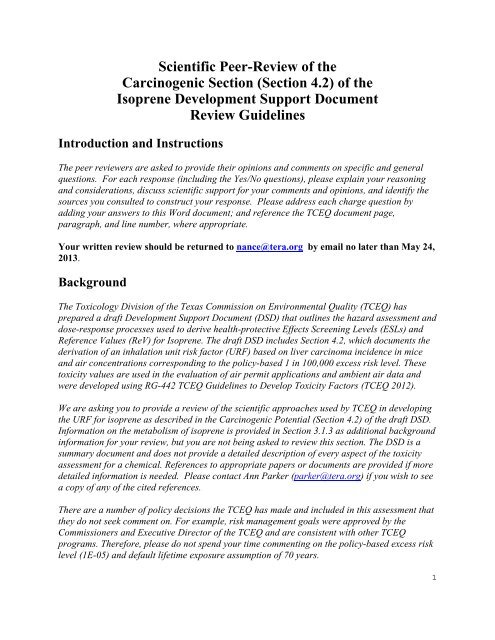Charge to Peer Reviewers - Tera
Charge to Peer Reviewers - Tera
Charge to Peer Reviewers - Tera
Create successful ePaper yourself
Turn your PDF publications into a flip-book with our unique Google optimized e-Paper software.
GeneralPlease evaluate strengths and weaknesses of the procedures used <strong>to</strong> develop the URF based onthe specific questions described below. Where possible, try <strong>to</strong> put the strengths and weaknessesin perspective by indicating their relative magnitude. Please try <strong>to</strong> avoid emphasizing minortechnical details. <strong>Reviewers</strong> should identify scientific uncertainties and suggest ways <strong>to</strong> reduceor eliminate those uncertainties.1. Does the draft DSD clearly describe the approaches used by TCEQ <strong>to</strong> develop theURF?2. Were procedures outlined in RG-442 TCEQ Guidelines <strong>to</strong> Develop Toxicity Fac<strong>to</strong>rs(TCEQ 2012) followed by the TCEQ in this assessment?3. Please identify any relevant studies or data that have not been cited and wouldaffect an important part of the assessment and explain how they would impact theassessment specifically.Cancer Assessment and Unit Risk Fac<strong>to</strong>r (URF)The draft Isoprene DSD describes the approaches used <strong>to</strong> evaluate carcinogenicity and derivethe URF and the chronic ESL (at the 1E-05 excess risk level) for cancer in Section 4.2. Pleasereview the key decisions made by TCEQ in deriving these values.In formulating your response <strong>to</strong> each question, please consider and comment on the consistencyof the assessment with TCEQ’s RG-442 guidelines, the scientific appropriateness of the decisionor conclusion, and any additional approaches or additional information that would improve thatdecision/conclusion.4. Section 4.2.3 briefly presents carcinogenic weight of evidence classificationinformation and conclusions of authoritative bodies and TCEQ’s weight of evidenceconclusion. Is TCEQ’s weight of evidence conclusion appropriate?2
5. Section 4.2.4 discusses isoprene’s carcinogenic mode of action (MOA). Have theauthors clearly and accurately summarized the available data and hypotheses forisoprene’s mode of action? [Please keep in mind that the purpose of the DSD is <strong>to</strong>document the derivation of the URF and ESL as opposed <strong>to</strong> being a comprehensiveweight of evidence paper on the MOA. Ultimately, if data on the MOA are notsufficient <strong>to</strong> justify an alternate approach <strong>to</strong> linear low-dose extrapolation, the DSDonly needs <strong>to</strong> generally summarize the primary proposed MOAs, MOA issues, andjustify use of the default extrapolation method.]6. Please comment on the following key decisions in the TCEQ assessment. For each,please discuss if the conclusions and choices are supported by the available data anddiscuss any additional information, data, or analyses that could improve thedecision.a. Were the most appropriate studies (Melnick et al., 1994a; Melnick et al.,1999; and Placke et al., 1996) selected for the dose-response assessment andwas their selection sufficiently described and justified?b. Adjustments were made <strong>to</strong> the data <strong>to</strong> account for differences between theexposure durations and times of response observation, continuous exposureduration, and number of study animals, (Section 4.2.6.1). Are theseadjustments biologically appropriate? Were the correct approaches used <strong>to</strong>adjust the data for each?c. Hepa<strong>to</strong>cellular carcinoma, alveolar/bronchiolar carcinoma, and histiocyticsarcoma were selected as human-relevant cancer endpoints for the doseresponseassessment. Was the selection of these endpoints clearly explainedand justified? Do you agree with what was chosen?d. Benchmark dose modeling was conducted on the adjusted data for theendpoints identified, with the EC 10 calculated for each cancer stage (m = 1, 2,3). Was it appropriate <strong>to</strong> base the final URF on the number of stages withthe lowest EC10? Do you agree with the selection of the best estimate, EC 10 ,(e.g., rather than the lower bound of the estimate, the LEC 10 ) as the point ofdeparture (POD), and did TCEQ authors provide sufficient justification forthis selection?3
e. Were the analyses in the Appendix on the data for the critical effectscorrectly performed and were the conclusions adequately justified?7. Did the dosimetric adjustments and conversion in<strong>to</strong> human equivalentconcentrations follow TCEQ guidance (Section 4.2.6.3)?8. The final URF was derived using a non-threshold approach using the best estimateexcess cancer risk resulting from continuous exposure <strong>to</strong> isoprene at 1 ppb in air foreach cancer stage and then selecting the most conservative EC 10 (cancer stage m=1)for use in deriving the ESL. Was this appropriate and does it result in the mostappropriate URF and chronic ESL nonthreshold(c) ?9. Did the document provide sufficient justification for the decision that isoprene hasnot been demonstrated <strong>to</strong> have a mutagenic MOA for liver carcinogenicity?10. Was the decision not <strong>to</strong> apply age-dependent adjustment fac<strong>to</strong>rs (ADAFs) (Section4.2.7) <strong>to</strong> the URF, <strong>to</strong> account for potential increased sensitivity of children, justifiedand properly considered given TCEQ guidance on evaluating the carcinogenicMOA (see Section 5.7.5 of TCEQ 2012)?11. Section 4.2.8 presents an uncertainty analysis. Have all the key uncertainties beenidentified? Are the conclusions regarding these uncertainty issues and their impac<strong>to</strong>n the URF correct and sufficiently discussed?12. Please identify any other relevant issues or questions that are important for thereview of this assessment.4





